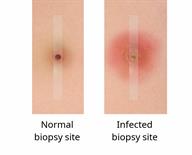ThisisPatientEngagementcontent
Skin Biopsy, Care After
Learn more about our Patient Engagement products now! Turn your patients into active participants in their healthcare by giving them easy access to the same evidence-based information you trust – but delivered in an easy-to-understand format.
After a small tissue of your skin is removed for testing, you may have soreness, mild pain, bruising, or itching in the areas that were cut. You may also have some redness and swelling.
Caring for your cut from surgery

General instructions
This information is not intended to replace advice given to you by your health care provider. Make sure you discuss any questions you have with your health care provider.
Cookies are used by this site. To decline or learn more, visit our cookie notice.
Copyright © 2025 Elsevier, its licensors, and contributors. All rights are reserved, including those for text and data mining, AI training, and similar technologies.